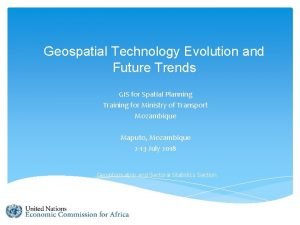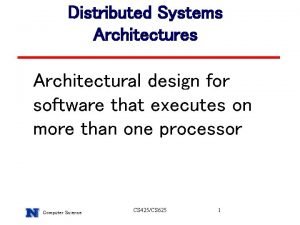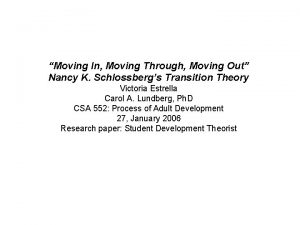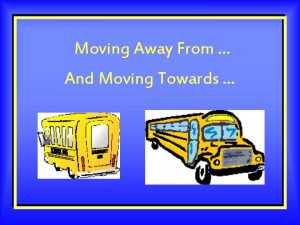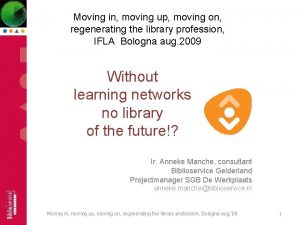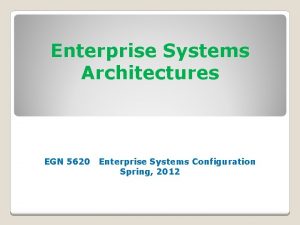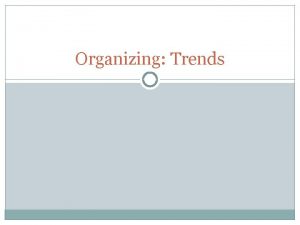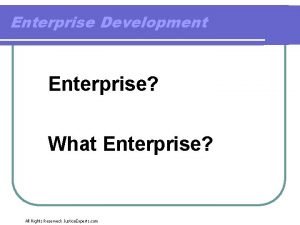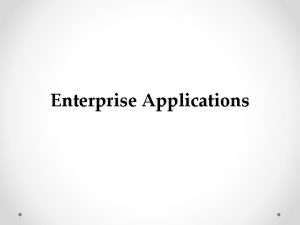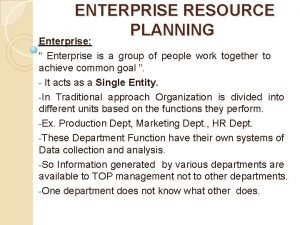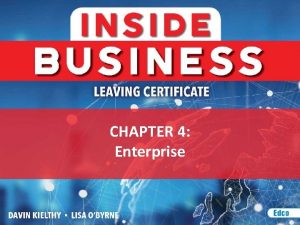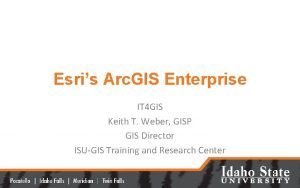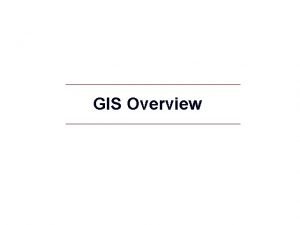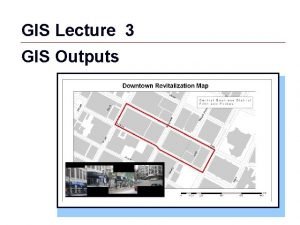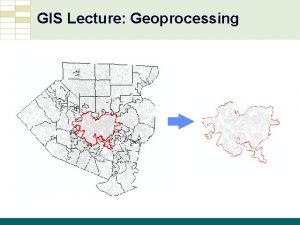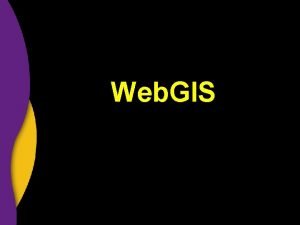GIS Enterprise Architectures The Trends Moving GIS into






















- Slides: 22

GIS Enterprise Architectures

The Trends - Moving GIS into the IT Mainstream § Tools § Integrated technology § Centralized § Distributed § Standalone § Embedded § GIS Data § Spatially enabled data § Mapping System § Database System § Legacy data migration § Legacy data access § Isolated spatial analysis § Enterprise spatial analysis

The Distributed World Evolving requirements on the PC platform 1990 Today § Users = Employees § Users = WWW § Leased lines § Virtual private nets § Alphanumeric data § Multimedia data § Serial development § Iterative development § Annual updates § JIT deployment § 7 x 24 = Exotic § 7 x 24 = Required § High priests § Real people

Enterprise GIS Goals • Centralized databases and applications. • Limited software and hardware components. • Single point of access to department wide data. • Access and distribution via networks.

Relational Database Integration • Interactive analytical capabilities • Geo-processing of relational data • Analysis across multiple spatial and attribute databases

GIS Workstations UNIX, Lenix and Windows Workstation Spatial Data Development Spatial Data Maintenance Spatial Data Conversion GIS Projects Map Production UNIX, Lenix and Windows Desktop GIS Applications Query and Analysis Ad Hoc Mapping General Operations Microsoft Windows Object Applications Embedded Applications Specific Operations Work Management Delivery Routing Emergency Response UNIX, Lenix and Windows Web. Mapping GIS Information Products Data Publishing Project Research Web-based Tools

GIS System Evolution File Server Utilities Department LAN Desktops Data Sharing Client/Server Personal GIS Utilities Departmental GIS Utilities IT File Servers Data Parks Assessor WAN Assessor IT Utilities WAN Desktops Data Web map Server WAN Parks Assessor Desktops Distributed Client/Server Data Warehouse Departmental GIS Operations Centralized Data Sharing Terminals/Browsers Centralized Database Enterprise GIS Operations Centralized Data Administration

GIS Enterprise Evolution GIS Data Marts Company GIS Utilities County GIS IT Data Web Map Server Desktops Intranet Desktops Parks Assessor Internet Terminals/Browsers City GIS Application Service Providers Terminals/Browsers Enterprise GIS Operations Department and Central Database Data Integration Terminal Servers Internet GIS Operations Shared Database Environments Data Integration

GIS Applications Network Impact What GIS Does. . . § Graphic Data Representation (Maps) § Large Quantity of Data Analysis § Lots of Network Traffic

Sample 1 -MB Map Display

Client/Server Protocols File Servers Data Server Query Processing on Server Data Typical Data Transfer 1 MB Spatial Data Cache NFS SMB TCP/IP Application Processing on Server UNIX Server WTS Server Applications Query Processing on Client Data Server Cache UNIX or Windows Clients X. 11 RDP ICA HTML/GIF Typical Data Transfer 100 KB Display Data Display/Control Cache Remote Terminal Clients X-Windows Terminals Web Browsers

Client/Server Performance Client/Server Communications Network Traffic Transport Time 56 Kbps 1. 54 Mbps 100 Mbps File Server to Workstation Client (NFS) • 1 MB 357 Sec. SDE Server to Workstation Client (SDE API) • 1 MB 89 Sec. UNIX Application Server to X-Terminal Client • 100 KB 18 Sec. 13 Sec. 2 Sec. 0. 2 Sec. 3. 2 Sec. 0. 5 Sec. 0. 05 Sec. 50% Data Compression 0. 6 Sec. 0. 1 Sec. 0. 01 Sec. Windows Terminal Server to Terminal Client (ICA) • 100 KB 0. 3 Sec. 0. 013 Sec. 0. 002 Sec. 0. 0002 Sec. Web Server to Browser Client (HTML/GIF) • 100 KB 0. 3 Sec. 0. 013 Sec. 0. 002 Sec. 0. 0002 Sec. Up to 98% Data Compression

GIS Product Architecture


The Shift To N-Tier r e i T 1 Monolithic/ Automation r e i T 2 Client/Server Corporate Applications (Often departmental) Mainframe Apps Mini-Computer Apps 1988 1990 1992 1994 r e i T N Internet/ Enterprise Distributed Production Web Aware/Web Scale e. Commerce 1996 1998

N-tier Architecture for the Web Client Business Rule Server Data Server

System Architecture Options Data Resources Files Attributes Performance Scalability High Availability Storage Area Network File/Image Server WTS GIS Server Web DBMS Server WWW Remote Sites 100 Mbps Ethernet WAN Desktops -Analysis -Maintenance -Operations -Studies Browsers -Map Products -Analysis -Operations -Studies Terminals -Analysis -Maintenance -Operations -Studies Laptops -Data Updates -Analysis Web Browsers -Data Download -Maps on Demand -Data Shipping


Multi-User Environment Web-GIS Server Map Server Feature Server Multi-User, Versioned OO-GIS DBMS Data Production Workstation Data Importer Workstation Desktop Clients -- Not webbased so don’t need Map Server

OO Database Behavior of different kinds of features can be stored and executed from the central database, instead of being repeated in each client application -- reduces traffic over the network v Object lifecycle rules v Data capture criteria v Data integrity validation rules v Multi-user conflict resolution rules v Symbolic representation rules Approved version Edit branches

Trends in Industry § Growing adoption of O-O web-enabled IT for GIS software development, marketing, distribution, support § Multi-user GIS with feature versioning for data production and maintenance § Integration of ODBMS with RDBMS in enterprise, with multi-tiered web-based application architectures

Industry Trends - 2 § Use of CORBA & Java technology for distributed applications § OLE for embedding maps within desktop applications § Open. GIS for cross-vendor interoperability § Support for multiple standard languages (C++, Java, Visual Basic) in commercial GIS products for different levels of applications and users within an enterprise
 Putting the enterprise into the enterprise system
Putting the enterprise into the enterprise system Putting the enterprise into the enterprise system
Putting the enterprise into the enterprise system Future trends
Future trends Enterprise search trends
Enterprise search trends Enterprise collaboration market trends
Enterprise collaboration market trends Scalable internet architectures
Scalable internet architectures Why systolic architectures
Why systolic architectures Aaron bannert
Aaron bannert Cdn architectures
Cdn architectures Ansi/sparc
Ansi/sparc Distributed systems architectures
Distributed systems architectures Architecture
Architecture How many tier data warehouse architecture?
How many tier data warehouse architecture? Switched backbone
Switched backbone Backbone network architectures
Backbone network architectures Gui architectures
Gui architectures Integral product architecture
Integral product architecture Types of isa in computer architecture
Types of isa in computer architecture Autoencoders, unsupervised learning, and deep architectures
Autoencoders, unsupervised learning, and deep architectures Gpu cache coherence
Gpu cache coherence Database system architectures
Database system architectures Database and storage architectures
Database and storage architectures E business architecture
E business architecture


